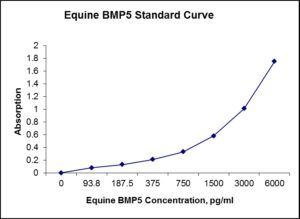Nori Equine BMP5 ELISA Kit
$461.00 – $832.00
This ELISA kit is for quantification of BMP5 in equine. This is a quick ELISA assay that reduces time to 50% compared to the conventional method, and the entire assay only takes 3 hours. This assay employs the quantitative sandwich enzyme immunoassay technique and uses biotin-streptavidin chemistry to improve the performance of the assays. An antibody specific for BMP5 has been pre-coated onto a microplate. Standards and samples are pipetted into the wells and any BMP5 present is bound by the immobilized antibody. After washing away any unbound substances, a detection antibody specific for BMP5 is added to the wells. Following wash to remove any unbound antibody reagent, a detection reagent is added. After intensive wash a substrate solution is added to the wells and color develops in proportion to the amount of BMP5 bound in the initial step. The color development is stopped, and the intensity of the color is measured.
Alternative names for BMP5: Bone morphogenetic protein 5 (BMP5)
This product is for Laboratory Research Use Only not for diagnostic and therapeutic purposes or any other purposes.
- Description
- How Elisa Works
- Product Citation (0)
- Reviews (0)
Description
Nori Equine BMP5 ELISA Kit Summary
Alternative names for BMP5: Bone morphogenetic protein 5 (BMP5)
Alternative names for equine: horse
| Assay Type | Solid Phase Sandwich ELISA |
| Format | 96-well Microplate or 96-Well Strip Microplate |
| Method of Detection | Colorimetric |
| Number of Targets Detected | 1 |
| Target Antiben Accession Number | A0A9L0RFJ6 |
| Assay Length | 3 hours |
| Quantitative/Semiquantitative | Quantitative |
| Sample Type | Plasma, Serum, Cell Culture, Urine, Cell/Tissue Lysates, Synovial Fluid, BAL, |
| Recommended Sample Dilution (Plasma/Serum) | No dilution for sample <ULOQ; sufficient dilution for samples >ULOQ |
| Sensitivity | 18 pg/mL |
| Detection Range | 93.8-6000 pg/mL |
| Specificity | Equine BMP5 |
| Cross-Reactivity | < 0.5% cross-reactivity observed with available related molecules, < 50% cross-species reactivity observed with species tested. |
| Interference | No significant interference observed with available related molecules |
| Storage/Stability | 4 ºC for up to 6 months |
| Usage | For Laboratory Research Use Only. Not for diagnostic or therapeutic use. |
| Additional Notes | The kit allows for use in multiple experiments. |
Standard Curve
Kit Components
1. Pre-coated 96-well Microplate
2. Biotinylated Detection Antibody
3. Streptavidin-HRP Conjugate
4. Lyophilized Standards
5. TMB One-Step Substrate
6. Stop Solution
7. 20 x PBS
8. Assay Buffer
Other Materials Required but not Provided:
1. Microplate Reader capable of measuring absorption at 450 nm
2. Log-log graph paper or computer and software for ELISA data analysis
3. Precision pipettes (1-1000 µl)
4. Multi-channel pipettes (300 µl)
5. Distilled or deionized water
Protocol Outline
1. Prepare all reagents, samples and standards as instructed in the datasheet.
2. Add 100 µl of Standard or samples to each well and incubate 1 h at RT.
3. Add 100 µl of Working Detection Antibody to each well and incubate 1 h at RT.
4. Add 100 µl of Working Streptavidin-HRP to each well and incubate 20 min at RT.
5. Add 100 µl of Substrate to each well and incubate 5-30 min at RT.
6. Add 50 µl of Stop Solution to each well and read at 450 nm immediately.
Background:
Bone morphogenetic protein 5 (BMP5) is a protein that in humans is encoded by the BMP5 gene.[1][2] and is a member of the TGFβ superfamily. Bone morphogenetic proteins are known for their ability to induce bone and cartilage development. BMP5 may play a role in certain cancers. Like other BMP’s BMP5 is inhibited by chordin and noggin. It is expressed in the trabecular meshwork and optic nerve head and may have a role in the development and normal function. It is also expressed in the lung and liver. Bone morphogenetic proteins were originally identified by an ability of demineralized bone extract to induce endochondral osteogenesis in vivo in an extraskeletal site. These proteins are synthesized as prepropeptides, cleaved, and then processed into dimeric proteins. This protein may act as an important signaling molecule within the trabecular meshwork and optic nerve head and may play a potential role in glaucoma pathogenesis. This gene is differentially regulated during the formation of various tumors.
References
- Hahn GV, et al. (1992). “A bone morphogenetic protein subfamily: chromosomal localization of human genes for BMP5, BMP6, and BMP5”. Genomics 14 (3): 759–62.
- Beck HN, et al. (2003). “Bone morphogenetic protein-5 (BMP-5) promotes dendritic growth in cultured sympathetic neurons”. BMC Neurosci 2: 12.
Be the first to review “Nori Equine BMP5 ELISA Kit”
You must be logged in to post a review.





























Reviews
There are no reviews yet.